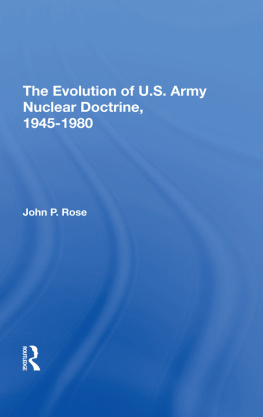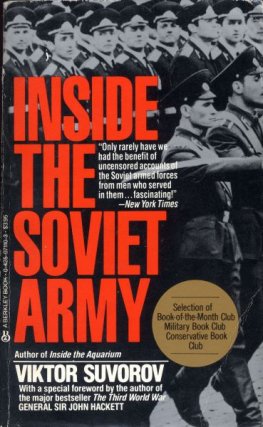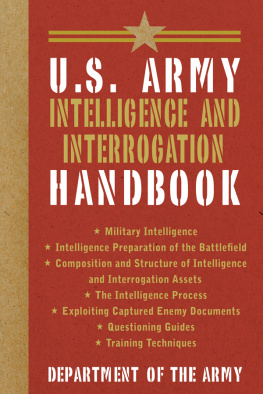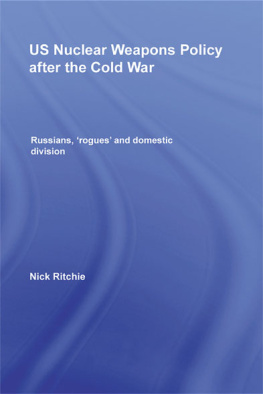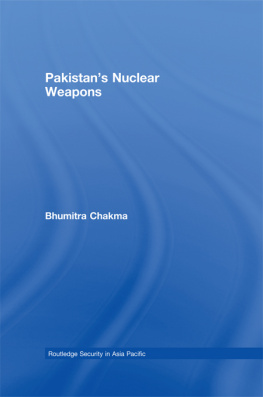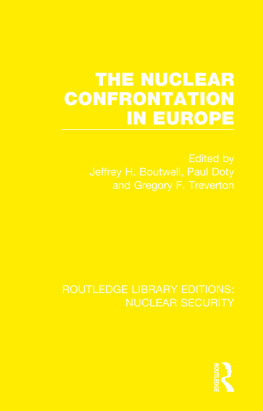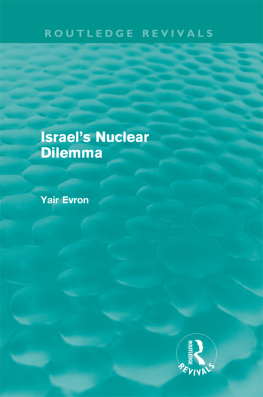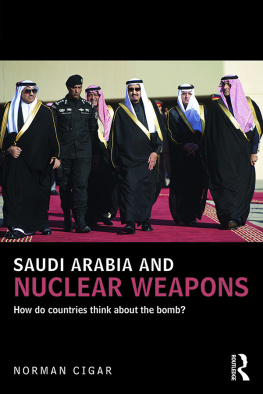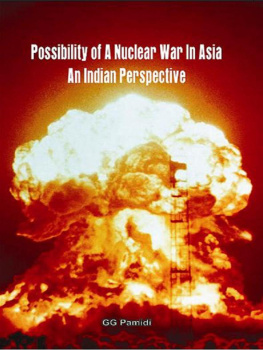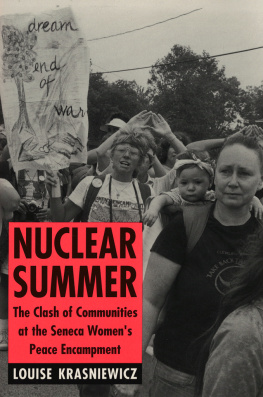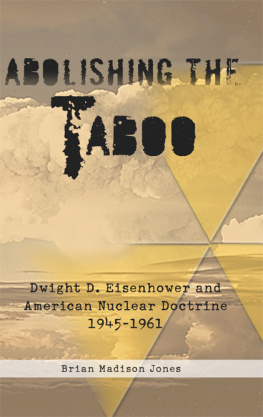The Evolution of U.S. Army Nuclear Doctrine, 19451980
Westview Replica Editions
This book is a Westview Replica Edition. The concept of Replica Editions is a response to the crisis in academic and informational publishing. Library budgets for books have been severely curtailed; economic pressures on the university presses and the few private publishing companies primarily interested in scholarly manuscripts have severely limited the capacity of the industry to properly serve the academic and research communities Many manuscripts dealing with important subjects, often representing the highest level of scholarship, are today not economically viable publishing projects. Or, if they are accepted for publication, they are often subject to lead times ranging from one to three years. Scholars are understandably frustrated when they realize that their first-class research cannot be published within a reasonable time frame, if at all.
Westview Replica Editions are our practical solution to the problem. The concept is simple. We accept a manuscript in camera ready form and move it immediately into the production process. The responsibility for textual and copy editing lies with the author or sponsoring organization. If necessary we will advise the author on proper preparation of footnotes and bibliography. We prefer that the manuscript be typed according to our specifications, though it may be acceptable as typed for a dissertation or prepared in some other clearly organized and readable way. The end result is a book produced by lithography and bound in hard covers. Initial edition sizes range from 600 to 800 copies, and a number of recent Replicas are already in second printings. We include among Westview Replica Editions only works of outstanding scholarly quality or of great informational value and we will continue to exercise our usual editorial standards and quality control.
The Evolution of U.S. Army Nuclear Doctrine, 19451980
John P. Rose
The development of U.S. Army nuclear doctrinepolicies, plans, procedures, tactics, and techniquessince World War II, its impact on Army forces, and its role in future wars is the subject of this policy-oriented analysis. The definition of Army nuclear doctrine advanced by the author clearly implies a distinction between policy for the employment of nuclear weapons as determined by the president and the role adduced by the Army.
Dr. Rose suggests that developmentsboth nuclear and conventionalin U.S. Army tactical doctrine have been more responsive to political preferences held by national authorities than to the real nature of the potential threat and rigors of the nuclear battlefield. Further, he argues that the type of war preparations favored by U.S. political authorities over the last fifteen years and the type of war for which the Soviet Union is preparing differ markedly, making the U.S. Army poorly prepared for a major war.
Major John P. Rose received a Ph.D. in international relations from the University of Southern California and is currently on the faculty of the Department of Social Sciences at the U.S. Military Academy, West Point.
First published 1980 by Westview Press
Published 2019 by Routledge
52 Vanderbilt Avenue, New York, NY 10017
2 Park Square, Milton Park, Abingdon, Oxon OX14 4RN
Routledge is an imprint of the Taylor & Francis Group, an informa business
Copyright 1980 Taylor & Francis
All rights reserved. No part of this book may be reprinted or reproduced or utilised in any form or by any electronic, mechanical, or other means, now known or hereafter invented, including photocopying and recording, or in any information storage or retrieval system, without permission in writing from the publishers.
Notice:
Product or corporate names may be trademarks or registered trademarks, and are used only for identification and explanation without intent to infringe.
Library of Congress Cataloging in Publication Data
Rose, John P.
The evolution of u.s. Army nuclear doctrine, 19451980.
(A Westview replica edition)
Bibliography: p.
1. United States. Army--History. 2. United States--Military policy.
3. Atomic warfare. 4. Atomic weapons, Tactical. I. Title.
UA25.R75 355.02170973 80-23964
ISBN 13: 978-0-367-29196-9 (hbk)
Winston Churchill understood tanks. The theory on how to use tanks in a rapid assault motion was an innovation of General Charles de Gaulle. When one thinks of the operational use of tanks in combat it was the German armys blitzkrieg tactics that prevailed. So it wasnt to the inventor or the theorist but to the one that operationalized the concept that the greatest advantage accrued. Thus it may be with nuclear weapons and nuclear combat. The United States well understands the technical aspects of the weapons and Western strategic thinkers have long theorized about their utility in land combat, but only the Soviet military actively trains and equips its forces for nuclear combat and has a we11-developed doctrinal concept for their employment on the battlefield.
No single modern-day achievement has had such a far-reaching effect upon United States military policy and tactical doctrine as the development of nuclear technology. Despite more than three decades of debate, many defense analysts and commentators seem unable to adopt a realistic approach to the realities of tactical nuclear weapons and nuclear warfare. The popular image of a huge mushroom cloud over the battlefield continues to debilitate thinking and planning for nuclear combat. We have become so preoccupied with the mushroom cloud that we have failed to think through what goes on beneath it.
This book was written because of a serious concern and a strong conviction. The concern is that the massive Soviet military buildup and modernization seem to suggest preparation for war. The conviction is that we shall lose the next war unless we clear from our minds several fundamental illusions about nuclear weapons that act to minimize our efforts to accomplish our tactical missionvictory in battle. Time is not on our side. The need and urgency for action should be apparent. A sense of urgency exists because we have no adequate nuclear battlefield doctrine with which to train our soldiers on how to fight, survive and win in a nuclear environment. In spite of a continued Soviet emphasis and preparation for nuclear combat our thinking about nuclear weapons has been handicapped by our habit in the past two decades of seeking the easy way to do everything. Above all, this book is a call for change in the habit of thought about the dynamics of future war.
It is the armys job to be prepared for war. It must ultimately be able to engage in successful land warfare, that is, to close with and defeat the nations enemies in land combat. While there is generally no accepted description of the nature of the next war, the army must plan and prepare for the courses of action most likely to be followed and to ensure success if hostilities should break out. Experience shows that the army which creates an organization, armament, and tactics corresponding to the future forms of war will secure for itself decisive advantages. The failure of the army to develop and practice tactics and techniques appropriate to nuclear technology is courting defeat on the nuclear battlefield.
John P. Rose
West Point, New York
July 1980

